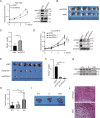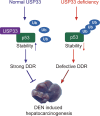USP33 Regulates DNA Damage Response and Carcinogenesis Through Deubiquitylating and Stabilising p53
- PMID: 39694539
- PMCID: PMC12099211
- DOI: 10.1111/cpr.13793
USP33 Regulates DNA Damage Response and Carcinogenesis Through Deubiquitylating and Stabilising p53
Abstract
The de-ubiquitinase USP33 has been shown to possess either tumour-promoting or inhibitory effect on human cancer cells. However, all these findings are mainly based on in vitro cell culture models, and the in vivo evidence, which is more plausible to digest the functional role of USP33 in carcinogenic process, is still lacking. Here, we demonstrate that USP33 modulates DNA damage responses including cell cycle arrest and apoptosis induction through associating with p53. It directly interacts with p53 to mediate its de-ubiquitination and further stabilisation under DNA damage condition. Depletion of USP33 induces an enhanced level of p53 ubiquitination, which de-stabilises p53 protein leading to impaired DNA damage responses. Furthermore, USP33 silencing shows either promoted or inhibited effect on cell proliferation in human cancer cells with p53 WT and mutant background, respectively. Consistently, mice with hepatocyte-specific USP33 knockout are more sensitive to nitrosodiethylamine (DEN)-induced hepatocarcinogenesis compared to wild type mice. Thus, our in vitro and in vivo evidences illustrate that USP33 possesses anti-tumour activity via regulating p53 stability and activity.
© 2024 The Author(s). Cell Proliferation published by Beijing Institute for Stem Cell and Regenerative Medicine and John Wiley & Sons Ltd.
Conflict of interest statement
The authors declare no conflicts of interest.
Figures





Similar articles
-
USP49 participates in the DNA damage response by forming a positive feedback loop with p53.Cell Death Dis. 2018 May 1;9(5):553. doi: 10.1038/s41419-018-0475-3. Cell Death Dis. 2018. PMID: 29748582 Free PMC article.
-
USP33 deubiquitinates PRKN/parkin and antagonizes its role in mitophagy.Autophagy. 2020 Apr;16(4):724-734. doi: 10.1080/15548627.2019.1656957. Epub 2019 Aug 26. Autophagy. 2020. PMID: 31432739 Free PMC article.
-
Reduced USP33 expression in gastric cancer decreases inhibitory effects of Slit2-Robo1 signalling on cell migration and EMT.Cell Prolif. 2019 May;52(3):e12606. doi: 10.1111/cpr.12606. Epub 2019 Mar 21. Cell Prolif. 2019. PMID: 30896071 Free PMC article.
-
Decision for cell fate: deubiquitinating enzymes in cell cycle checkpoint.Cell Mol Life Sci. 2016 Apr;73(7):1439-55. doi: 10.1007/s00018-015-2129-2. Epub 2016 Jan 13. Cell Mol Life Sci. 2016. PMID: 26762302 Free PMC article. Review.
-
The role of DNA damage responses in p53 biology.Arch Toxicol. 2015 Apr;89(4):501-17. doi: 10.1007/s00204-015-1459-z. Epub 2015 Jan 25. Arch Toxicol. 2015. PMID: 25618545 Review.
Cited by
-
Phosphorylation of USP33 by CDK1 stabilizes the mTORC2 component SIN1.Cell Death Dis. 2025 Jul 22;16(1):543. doi: 10.1038/s41419-025-07869-6. Cell Death Dis. 2025. PMID: 40695806 Free PMC article.
References
-
- Chen J., Shan W., Jia Q., et al., “USP33 Facilitates the Ovarian Cancer Progression via Deubiquitinating and Stabilizing CBX2,” Oncogene 43 (2024): 3170–3183. - PubMed
MeSH terms
Substances
Grants and funding
- 2019YFA0801702/National Key R&D Program of China
- 32121001/the Innovative Research Group Program of National Science Foundation of China
- 2021096/Youth Innovation Promotion Association Foundation of Chinese Academy of Sciences of China
- XDA0460403/the Strategic Priority Research Program of the Chinese Academy of Sciences
LinkOut - more resources
Full Text Sources
Research Materials
Miscellaneous

